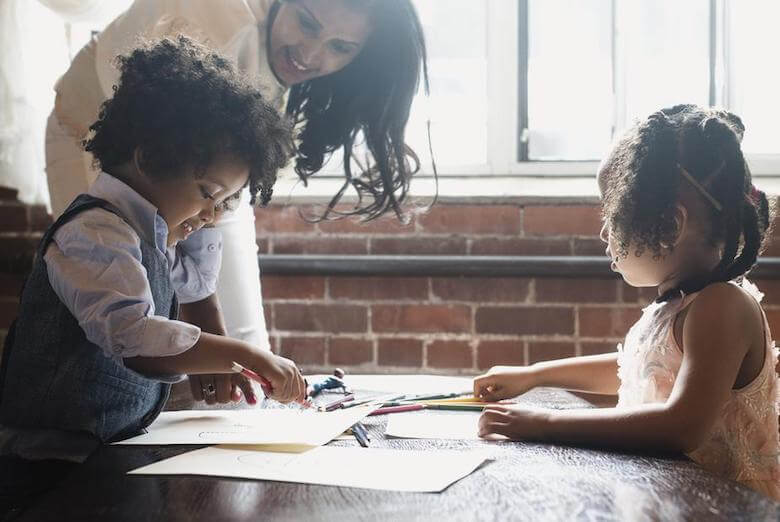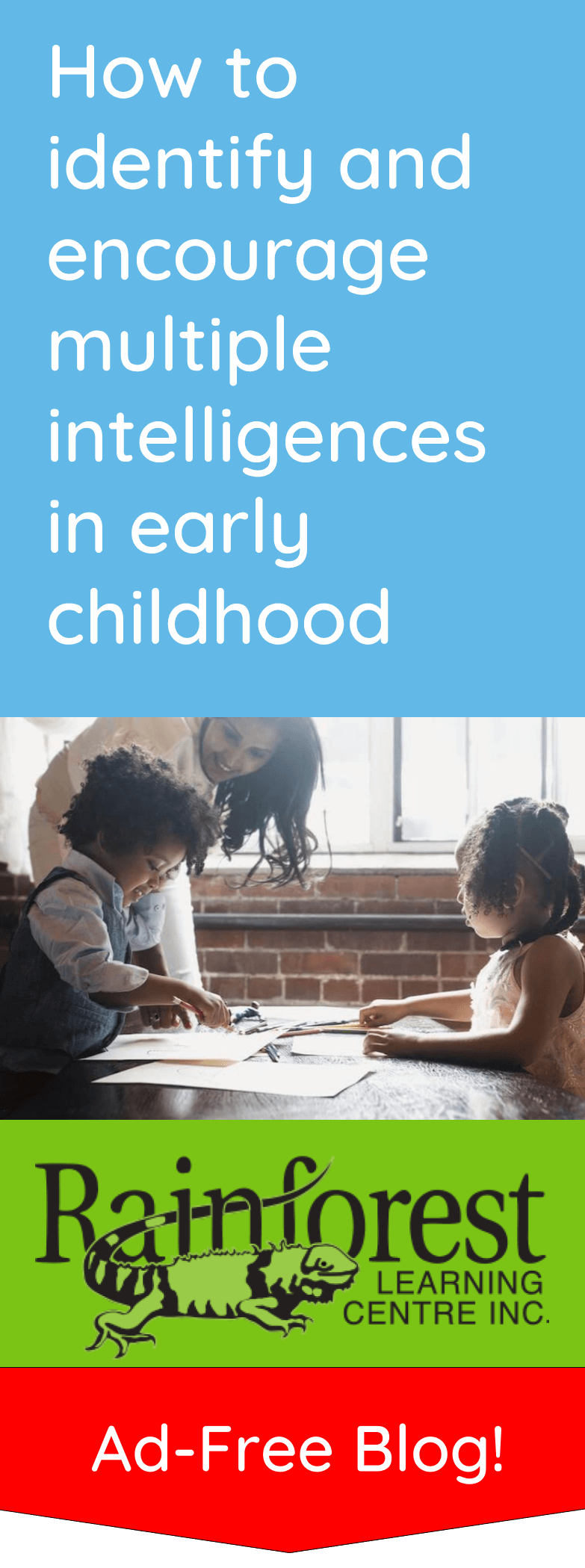
In the education world, it is well known that children benefit from having multiple ways of engaging with content and showing their understandings. Some may explain this simply by saying that each child has their own ‘learning style.’ In other words, some kids may be identified as wanting to move around all day, while others might prefer to sit down and read a picture book. But what is this talk about multiple intelligences in early childhood?
This is a common theme you may hear of throughout your children’s education. However, Dr. Howard Gardner of Harvard University suggests that everyone actually possesses nine different forms of intelligence to varying degrees. This means that we should not label children with a particular learning style or intelligence, since they have them all! In fact, knowing about this pedagogical theory can help educators understand human learning in a whole new way.
See related: Is my toddler or preschooler gifted? What are the early signs of intellectual giftedness?
Recognizing the multiple intelligences in early childhood
Even in the early years of childhood, you can begin to identify which intelligences a child may be stronger in. Below are all of Gardner’s multiple intelligences, along with a few identifying factors as examples to help you recognized them. These were mostly adapted from Very Well Mind and The Child Development Institute.
1. Linguistic-Verbal Intelligence
- Has a strong acumen for reading, writing and telling stories.
- Gives good explanations and can articulate well through vocabulary.
See related:
- 4 Benefits of kids telling their own stories
- Why is literacy crucial in the early years? How can parents and preschools help with reading skills?
- What is the best way to teach word recognition to early childhood readers?
- How to teach digraphs to preschool children (6 ways)
2. Logical-Mathematical Intelligence
- Demonstrates problem-solving skills, especially in mathematics.
- Curious about how things work.
See related:
- How to teach toddlers and preschoolers to count, and learn their numbers
- 8 Ideas to teach preschoolers about money management and why it’s important
- How to find and use teachable moments as an early childhood educator
- 13 apps to help young kids learn
- How to teach preschoolers about viruses, bacteria and sickness prevention (cold and flu teaching tips)
- 4 Easy science experiments for toddlers and preschoolers, and more
3. Visual-Spatial Intelligence
- Able to recall visual details.
- Skilled at visual recognition, such as by completing puzzles easily or recognizing graphical patterns.
- Enjoys creating and engaging with visual arts.
See related:
- Ideas for teaching shapes in preschool and daycare
- The benefit of process art in preschool classrooms
- Essential props to have or make for your preschool dramatic play corner
- How to teach colours to toddlers and preschoolers
4. Bodily-Kinesthetic Intelligence
- Generally good at sports or dancing, and skills that require dexterity, or the body in some way.
- Enjoys creating things with their hands, and physically touching objects.
See related:
- The benefits of dancing at daycare and preschool
- Why teach kids yoga at daycare? Here are 3 great reasons!
- Preschool sports ideas to play in early childhood, and their benefits
- What is normal gross motor development in early childhood, and why is it important?
- Why sensory development skills are important at daycare
5. Musical Intelligence
- Understands their ‘world’ through traits that music requires, such as rhythms, patterns, compositions, and so on.
- Generally good at picking up instrument skills.
- Easily recognizes musical patterns and tones, especially when sounds are off-key.
- Sensitive to sound, and responds emotionally to music.
See related:
- How music affects young children and their learning
- 5 Preschool guest instructors to invite to your early childhood classroom
6. Interpersonal Intelligence
- Able to empathize with others.
- Able to recognize the moods and inner feelings of those around them.
- Enjoys helping others with problem-solving, or by being a good listener and understander of what they’re experiencing.
- Develops healthy relationships, and enjoys people.
See related:
- What is normal emotional intelligence in toddlers and preschoolers?
- 3 ways early childhood educators can help kids get along and feel included
- 4 Benefits of daycare ‘buddy time,’ when older kids mentor preschoolers
- What is social competence in the early years?
7. Intrapersonal Intelligence
- Shows independence and individuality in their work and personal life.
- Can express how they are feeling, and are generally aware of what is going on inside them, emotionally and psychologically (considering that some life situations can create inner ‘confusions’ for many people).
See related:
- How to teach impulse control in early childhood
- What are age-appropriate manners for preschoolers in early childhood?
- How to know if your child is emotionally ready for school
- The importance of teaching kids decision-making skills in early childhood
- 3 ways to build self-awareness in early childhood
8. Naturalistic Intelligence
- Enjoys learning about plants and animals.
- Enjoys playing in water or with pets and bugs, and generally enjoys all things outdoors.
- Passionate about nature conservation efforts.
See related:
- Preschool activities to start, grow and maintain an edible classroom garden
- Reasons and ideas to teach preschoolers about recycling
- 4 Top benefits of outdoor education in early childhood
- 5 Fun, purpose-driven walks to go on with daycare kids or preschoolers
- Community service learning ideas for early childhood education and daycare
9. Existential Intelligence
- Questions subjects such as the meaning of human life and our existence.
- Leads a spiritual life, or one that is inquisitive about the ‘unseen.’
See related:
- 12 Space-themed crafts & activities for preschool or daycare classrooms
- 5 examples (types) of informal education in early childhood
- 5 Imagination games to play with toddlers and young kids
- Why are ‘home values’ important for child development and in early childhood education?
Sources on how to develop multiple intelligences with early childhood education
As we hinted above, your child may show signs of strength in a few of these above-mentioned intelligences. But this doesn’t mean they can’t become strong in all of them! According to Edutopia, it is important to give children “multiple ways to access content,” along with “multiple ways to demonstrate knowledge and skills.” These two practices will not only help to captivate students and increase their learning, but will help to develop interests and skills they might not have much experience with. Children can also learn to dive into subjects more deeply, giving them broader understandings that affect all the intelligences they have within them.
The American Institute for Learning and Human Development also points out that you could provide eight different pathways to learning for a single topic that align with these multiple intelligences.
Another idea that Early Childhood News suggests is having learning centres for young learners that focus on each of these eight intelligences. For example, you could have a cooking area, sensory learning centre, an art centre, and an instrument or sound-creation centre. The idea is that each of these centres would help strengthen a different intelligence in young learners.
Scholastic also has a very detailed list of specific ideas for developing eight of the intelligences in a classroom or daycare, which you can check out here.
Plus, see related articles on our blog:
- What is experiential education in early childhood, and why is it important?
- Why sensory development skills are important at daycare
- The benefits of Emergent Curriculum in preschool
- What makes a good daycare space design?
Use the theory of multiple intelligences to make useful observations of young children
As your children begin their education, it is definitely important to make observations of how they approach learning. This will help you, and early childhood educators, to determine the best learning environment, or methods for your child. Not only that, you can take a step beyond looking at your child’s ‘learning style.’ You can use these observations to identify the intelligences they lean more towards. This can give you the opportunity to help your child develop all eight – or even nine – of Gardner’s proposed intelligences. Or, it can help make children well-rounded learners early in life.
